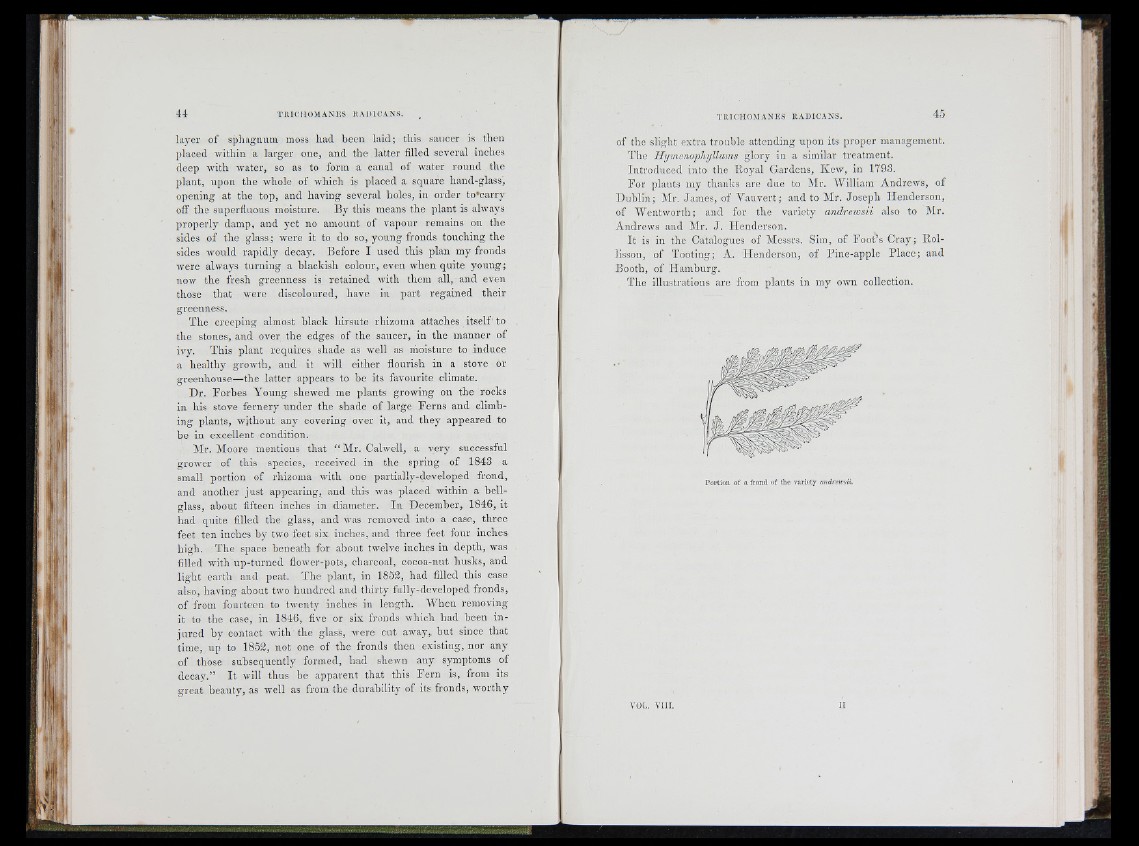
layer o f sphagnum moss h a d been la id ; this saucer is then
jdaced within a la rg e r one, and th e la tte r filled several inches
deep with water, so as to form a canal of water ro u n d the
p lan t, upon the whole of which is placed a squa re hand-glass,
opening at the top, and having several holes, in o rd e r to 'c a r ry
off the superfluous moisture. B y this means the p lan t is always
p ro p e rly damp, and y e t no amount of vapour remains on tho
sides of the glass; were it to do so, y oung fronds touch in g th e
sides would rap id ly decay. Before I used this plan my fronds
were always tu rn in g a blackish colour, even when q uite yo u n g ;
now the fresh greenness is re ta in ed with them all, and even
those th a t were discoloured, have in p a rt reg a in ed th e ir
greenness.
T h e creeping almost black h irsu te rhizoma attaches itse lf to
th e stones, and over the edges of th e saucer, in th e man n e r of
ivv. This p lan t req u ire s shade as well as moisture to induce
a h e a lth y growth, and it will eith e r flourish in a stove or
greenhouse—the la tte r appears to be its favourite climate.
D r. F o rb e s Y o u n g shewed me plants g rowing on th e rocks
in his stove fe rn e ry u n d e r th e shade of large F e rn s an d climbing
plants, w ith o u t any covering over it, an d th ey ap p e a red to
be in ex cellent condition.
M r. jMoore mentions th a t “ Mr. Calwell, a v e ry successful
grower of this species, received in th e spring o f 1843 a
small portion of rhizoma with one p artially-developed frond,
and another ju s t ap p e a rin g , and this was placed within a bell-
glass, about fifteen inches in diameter. I n Decembe r, 1846, it
h ad q uite filled th e glass, and was removed into a case, th re e
feet ten inches b y two feet six inches, and th re e feet four inches
high. T h e space b eneath for about twelve Inches in d ep th , was
filled with u p -tu rn e d flower-pots, charcoal, cocoa-nut h usks, and
lig h t earth and peat. T h e plan t, in 1852, h a d filled this case
also, having about two h u n d re d and th irty fnlly-developed fronds,
o f from fo u rte en to tw en ty inches in length. MYen removing
it to th e case, in 1840, five or six fronds which h ad been in ju
r e d b y contact w ith the glass, were cu t away, b u t since th a t
time, up to 1852, n o t one of th e fronds th en existing, n o r any
of those subsequently formed, h ad shewn any symptoms of
decay.” I t will thus be ap p a ren t th a t this F e rn is, from its
g re a t beau ty , as well as from the d u rab ility of its fronds, w o rth y
of the slight ex tra trouble a ttending u pon its p ro p e r management.
Tlie Ilijinenopliyllwns glory in a similar tre a tm en t.
In tro d u c ed into the Roya l Gard en s, K ew , in 1793.
F o r plants my thanks are due to Mr. W illiam A n d rew s, of
D u b lin ; IMr. James, of V a u v e rt; and to M r. Jo sep h H en d e rso n ,
o f W e n tw o rth ; and for the v ariety and rew sii also to Mr.
Andrews and Mr. J . H en d e rso n .
I t is in tho Catalogues of Messrs. Sim, of F o o t’s C ra y ; Rol-
lisson, of T o o tin g ; A. H en d e rso n , of P in e -ap p le P la c e ; and
Booth, of H am b u rg .
T h e illustrations are from plants in my own collection.
Portion of a frond of the variety andrcxniu
VOL. VIII.